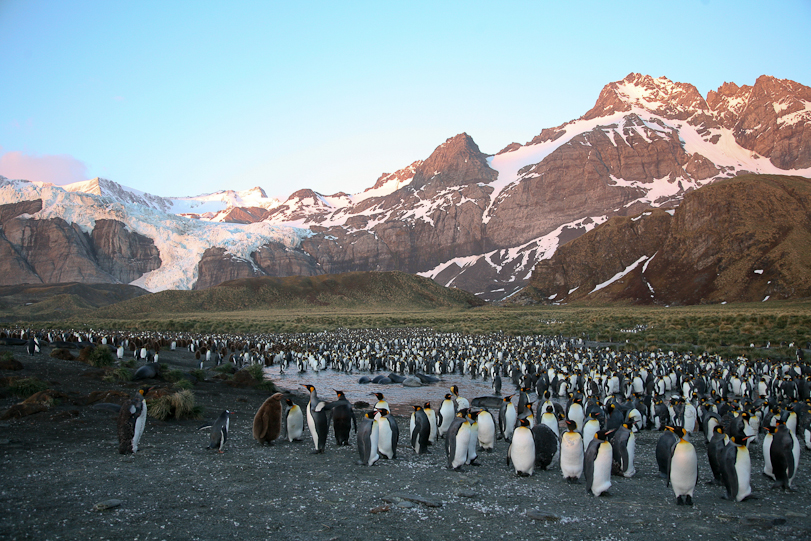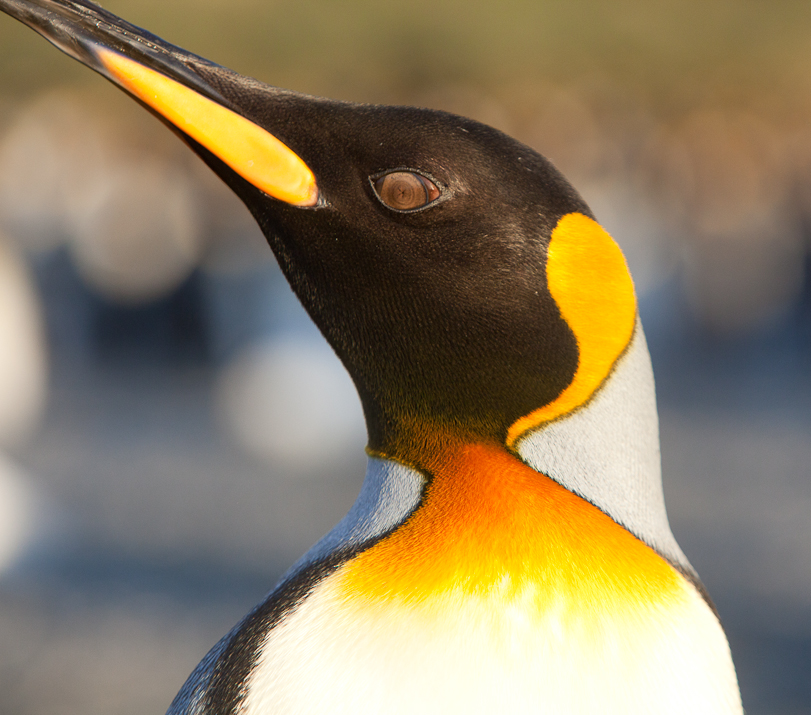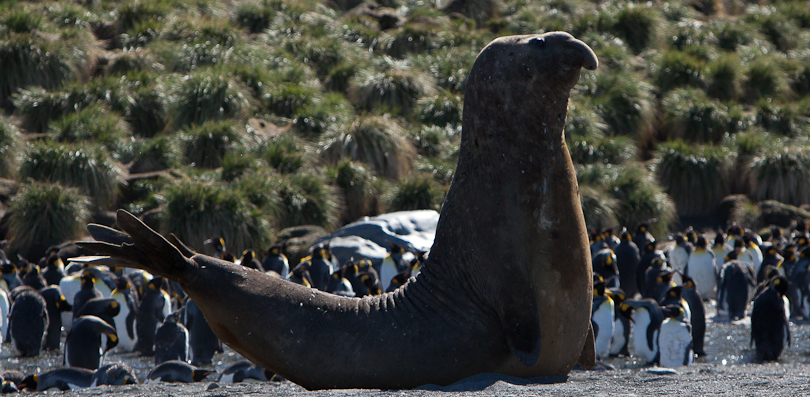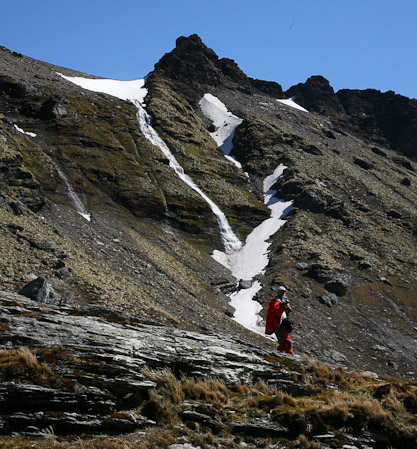
0500am wake-up call. We are not on your garden variety cruise ship. There was a sign-up sheet put out last night for those that were interested in this pre-dawn landing to so indicate. Practically the entire ship's complement signed up - another sign that this is not your standard cruise trip. We're on the Eastern side of South Georgia now, with a clear view of the early dawn. This is the reason they put our clocks back three hours, but sunrise is still about 6:30 am. We zodiac ashore in the half light and pick our way gingerly among the hulking elephant seals to a clear part of the beach.

As the sun comes up it paints the sky and the towering snow-covered peaks and hanging glaciers surrounding this bay. As it rises higher the light creeps further down the mountainside, eventually revealing on the order of 25,000 pairs (50,000 individual) King penguins!

These are the magnificent gold and orange birds so beloved of nature photographers and TV documentaries (well, no, not the March of the Penguin stars – those you have to travel to Antarctica and take a helicopter to see). See photo and you will instantly know the Kings.

Making our way further down the beach, we see the creche, full of the fuzzy brown “oakum boys;” the juveniles make a comic contrast to the elegant adults.

The cacophony here is amazing. Between the adult and juvenile penguins, and the adult and juvenile elephant seals, it sounds like an orchestra's worth of woodwinds gone mad combined with a giant's defective plumbing system. We've recorded a bit for later playback. Between the mating, fighting, and feeding elephant seals and the mating, feeding, and displaying Kings, everyone is just blown away. This is what we came for, this is why we are here. Photographers scramble for the iconic shots, then move about looking for that unique image that says “I was there”.

By 8:00 things begin to calm down a bit and about half of us zodiac back to the ship for a quick breakfast before returning to the beach. Others remained ashore for the full six hours of land time we had allocated for Gold Harbour.
Did we mention that the guidelines are that you have to keep 15 meters between yourself and the wildlife? There isn't a clear 15sq meters anywhere on this beach.. If you sit down for a moment, the penguins and the young seals walk up to -you-, too close to photograph. The one animal that commands more than 15 meters of leeway is the big multi-ton beachmaster, clearly the inspiration for Jabba the Hut. They mean humans no harm, but won't notice that they have crushed you to death on their way to challenge a rival elephant seal bull. The occasional crushed seal testifies to this fact.

The beach is crowded with other birds as well, the scavengers, Skuas and Giant Petrels and Snowy Sheathbills. Then there is the sheer grandeur of the place, the cliffs and towering peaks and glaciers. It's overwhelming.
After going back to the ship for breakfast, we head out again to spend the rest of the morning ashore. After lunch, we up anchor and head to Royal Bay, a deep bay surrounded by massive glaciers, some coming right down to the water and others hanging on the sides. While we watch in awe from the bridge, a great iceberg calves off the face in front of us.
Because this deep bay is somewhat protected, and the weather is still beautiful, they decide to get out the Kayaks. We decide to go ashore instead – there are reindeer here, in addition to many Fur Seals and Elephant Seals, and a few King Penguins. They were imported by the Norwegian whalers as a food source – just a few, 7 in one place and 10 in another – but their descendants are here still, two separate herds of several thousand animals.
The landscape is very different – the retreating glaciers have left long scored rock platforms, and the river coming from the bottom of the great Ross Glacier at the end winds in racing channels among beds of mosses and short grasses. The tussock grass is smaller and less dense. It is beautiful, and a pleasure to walk in.

We see the reindeer herd running toward us, then (probably catching sight of us) back up into the uplands and around into another bay. Later we learn that the change in the vegetation is because of the reindeer. There is some debate about whether to get rid of them. Although everyone loves to see them, they are an invasive species, just like rats, goats, pigs, and cats, and they are changing the ecology. One naturalist called them “antlered rats.”
It turns out to be just as well we decided not to kayak. While we were enjoying our walk in the sunshine, a 30-knot wind came up on the water and blew everyone away. A couple of kayaks made it back under their own power, but most had to be towed back, and the second round of kayaking was canceled. They will try for a more sheltered spot tomorrow.
Long day, and another dawn landing tomorrow – that's all for now.